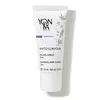What's inside
What's inside
 Key Ingredients
Key Ingredients

 Benefits
Benefits

 Concerns
Concerns

 Ingredients Side-by-side
Ingredients Side-by-side

Rosmarinus Officinalis Water
MaskingLz1 Peptide
Aloe Barbadensis Leaf Juice
Skin ConditioningGlycerin
HumectantTocopherol
AntioxidantWater
Skin ConditioningRosmarinus Officinalis Leaf Oil
MaskingHydrogenated Palm Kernel Oil
EmollientPEG-35 Castor Oil
EmulsifyingGlyceryl Stearate
EmollientPEG-100 Stearate
Cera Alba
EmollientCetyl Alcohol
EmollientCorylus Avellana Seed Oil
EmollientCamphor
MaskingSclerotium Gum
Emulsion StabilisingCarbomer
Emulsion StabilisingFagus Sylvatica Bud Extract
TonicTocopheryl Acetate 0.2%
AntioxidantBorneol
MaskingSodium Hydroxide
BufferingLavandula Angustifolia Oil
MaskingPelargonium Graveolens Leaf Oil
Cupressus Sempervirens Oil
MaskingThymus Vulgaris Flower/Leaf Oil
MaskingPhenoxyethanol
PreservativeChlorphenesin
AntimicrobialBenzyl Alcohol
PerfumingBenzoic Acid
MaskingLimonene
PerfumingLinalool
PerfumingCitronellol
PerfumingGeraniol
PerfumingCoumarin
PerfumingRosmarinus Officinalis Water, Lz1 Peptide, Aloe Barbadensis Leaf Juice, Glycerin, Tocopherol, Water, Rosmarinus Officinalis Leaf Oil, Hydrogenated Palm Kernel Oil, PEG-35 Castor Oil, Glyceryl Stearate, PEG-100 Stearate, Cera Alba, Cetyl Alcohol, Corylus Avellana Seed Oil, Camphor, Sclerotium Gum, Carbomer, Fagus Sylvatica Bud Extract, Tocopheryl Acetate 0.2%, Borneol, Sodium Hydroxide, Lavandula Angustifolia Oil, Pelargonium Graveolens Leaf Oil, Cupressus Sempervirens Oil, Thymus Vulgaris Flower/Leaf Oil, Phenoxyethanol, Chlorphenesin, Benzyl Alcohol, Benzoic Acid, Limonene, Linalool, Citronellol, Geraniol, Coumarin
Water
Skin ConditioningAloe Barbadensis Leaf Juice
Skin ConditioningHelianthus Annuus Flower
Skin ConditioningCetyl Alcohol
EmollientStearic Acid
CleansingGlyceryl Stearate
EmollientPolysorbate 20
EmulsifyingPEG-100 Stearate
Propanediol
SolventDimethicone
EmollientGlycolic Acid
BufferingCaprylic/Capric Triglyceride
MaskingPentylene Glycol
Skin ConditioningPhenylethyl Resorcinol
AntioxidantBisabolol
MaskingButyl Methoxydibenzoylmethane
UV AbsorberSalicylic Acid
MaskingArbutin
AntioxidantTocopheryl Acetate
AntioxidantPhyllanthus Emblica Extract
Skin ConditioningArctostaphylos Uva-Ursi Leaf Extract
Skin ConditioningRetinyl Palmitate
Skin ConditioningHydroxyethyl Acrylate/Sodium Acryloyldimethyl Taurate Copolymer
Emulsion StabilisingSodium Hydroxide
BufferingXanthan Gum
EmulsifyingParfum
MaskingPhenoxyethanol
PreservativeEthylhexylglycerin
Skin ConditioningWater, Aloe Barbadensis Leaf Juice, Helianthus Annuus Flower, Cetyl Alcohol, Stearic Acid, Glyceryl Stearate, Polysorbate 20, PEG-100 Stearate, Propanediol, Dimethicone, Glycolic Acid, Caprylic/Capric Triglyceride, Pentylene Glycol, Phenylethyl Resorcinol, Bisabolol, Butyl Methoxydibenzoylmethane, Salicylic Acid, Arbutin, Tocopheryl Acetate, Phyllanthus Emblica Extract, Arctostaphylos Uva-Ursi Leaf Extract, Retinyl Palmitate, Hydroxyethyl Acrylate/Sodium Acryloyldimethyl Taurate Copolymer, Sodium Hydroxide, Xanthan Gum, Parfum, Phenoxyethanol, Ethylhexylglycerin
Ingredients Explained
These ingredients are found in both products.
Ingredients higher up in an ingredient list are typically present in a larger amount.
Aloe Barbadensis Leaf Juice comes from leaves of the aloe plant. Aloe Barbadensis Leaf Juice is best known for helping to soothe sunburns. It is also anti-inflammatory, moisturizing, antiseptic, and can help heal wounds.
Aloe is packed with good stuff including Vitamins A, C, and E. These vitamins are antioxidants, which help fight free-radicals and the damage they may cause. Free-radicals are molecules that may damage your skin cells, such as pollution.
Aloe Barbadensis Leaf Juice also contains sugars. These sugars come in the form of monosaccharides and polysaccharides, folic acid, and choline. These sugars are able to help bind moisture to skin.
It also contains minerals such as calcium, 12 anthraquinones, fatty acids, amino acids, and Vitamin B12.
Learn more about Aloe Barbadensis Leaf JuiceCetyl Alcohol is a fatty alcohol. Fatty Alcohols are most often used as an emollient or to thicken a product.
Its main roles are:
Though it has "alcohol" in the name, it is not related to denatured alcohol or ethyl alcohol.
The FDA allows products labeled "alcohol-free" to have fatty alcohols.
Learn more about Cetyl AlcoholGlyceryl Stearate is a mix of glycerin and stearic acid.
It is used to stabilize the mixing of water and oil ingredients. By preventing these ingredients from separating, it can help elongate shelf life. It can also help thicken the product's texture.
As an emollient, it helps soften skin and supports barrier-replenishing ingredients.
In cosmetics, Glyceryl Stearate is often made from vegetable oils or synthetically produced.
This ingredient may not be fungal-acne safe
Fun fact: The human body also creates Glyceryl Stearate naturally.
Learn more about Glyceryl StearatePeg-100 Stearate is an emollient and emulsifier. As an emollient, it helps keep skin soft by trapping moisture in. On the other hand, emulsifiers help prevent oil and water from separating in a product.
PEGS are a hydrophilic polyether compound . There are 100 ethylene oxide monomers in Peg-100 Stearate. Peg-100 Stearate is polyethylene glycol ester of stearic acid.
Phenoxyethanol is a preservative that has germicide, antimicrobial, and aromatic properties. Studies show that phenoxyethanol can prevent microbial growth. By itself, it has a scent that is similar to that of a rose.
It's often used in formulations along with Caprylyl Glycol to preserve the shelf life of products.
Sodium Hydroxide is also known as lye or caustic soda. It is used to adjust the pH of products; many ingredients require a specific pH to be effective.
In small amounts, sodium hydroxide is considered safe to use. However, large amounts may cause chemical burns due to its high alkaline.
Your skin has a natural pH and acid mantle. This acid mantle helps prevent harmful bacteria from breaking through. The acid mantle also helps keep your skin hydrated.
"Alkaline" refers to a high pH level. A low pH level would be considered acidic.
Learn more about Sodium HydroxideTocopheryl Acetate is AKA Vitamin E. It is an antioxidant and protects your skin from free radicals. Free radicals damage the skin by breaking down collagen.
One study found using Tocopheryl Acetate with Vitamin C decreased the number of sunburned cells.
Tocopheryl Acetate is commonly found in both skincare and dietary supplements.
Learn more about Tocopheryl AcetateWater. It's the most common cosmetic ingredient of all. You'll usually see it at the top of ingredient lists, meaning that it makes up the largest part of the product.
So why is it so popular? Water most often acts as a solvent - this means that it helps dissolve other ingredients into the formulation.
You'll also recognize water as that liquid we all need to stay alive. If you see this, drink a glass of water. Stay hydrated!
Learn more about Water